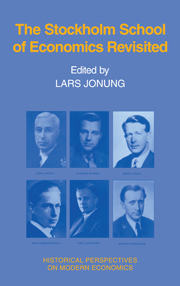Book contents
- Frontmatter
- Dedication
- Contents
- Preface
- List of Contributors
- Dramatis Personae at the end of 1937
- Introduction and Summary
- Part I The roots
- 1 The Political Economy Club and the Stockholm School, 1917–1951
- 2 Gösta Bagge, the Rockefeller Foundation, and empirical social science research in Sweden, 1924–1940
- 3 The Committee on Unemployment and the Stockholm School
- Comment
- Comment
- Part II The approach of the Stockholm School
- Part III The impact of the Stockholm School
- Part IV What remains of the Stockholm School?
- The Stockholm School: A non-Swedish bibliography
Comment
Published online by Cambridge University Press: 05 July 2013
- Frontmatter
- Dedication
- Contents
- Preface
- List of Contributors
- Dramatis Personae at the end of 1937
- Introduction and Summary
- Part I The roots
- 1 The Political Economy Club and the Stockholm School, 1917–1951
- 2 Gösta Bagge, the Rockefeller Foundation, and empirical social science research in Sweden, 1924–1940
- 3 The Committee on Unemployment and the Stockholm School
- Comment
- Comment
- Part II The approach of the Stockholm School
- Part III The impact of the Stockholm School
- Part IV What remains of the Stockholm School?
- The Stockholm School: A non-Swedish bibliography
Summary
As one of the authors who in recent decades have discussed, in their work on macroeconomic theory and policy in Sweden at the time of the Great Depression, the relation of the Stockholm School to the Swedish Committee on Unemployment – most notably Landgren (1960), Steiger (1971, 1976, 1978b), Uhr (1977), and Ohlin (1981) – I am impressed by the richness of the unpublished and, with two exceptions, hitherto unknown material from the Committee discovered by Eskil Wadensjö. It goes without saying that Wadensjö is able to offer only an outline of these new sources in his presentation. In spite of some more detailed information on the contributions of Ernst Wigforss and Bertil Ohlin, this new material allows only tentative conclusions to be drawn on how our view of the Stockholm School ought to be revised. For a fuller acount, we have to wait for Wadensjö's forthcoming edition of the Committee's unpublished memoranda.
Unfortunately, in his contribution Wadensjö does not provide an account of the earlier debate on the origin, ideas, and development of the Stockholm School as well as its importance for Swedish policy on reducing cyclical fluctuations by credit-financed public works vis-à-vis the role of Ernst Wigforss, the Social Democratic politician and Minister of Finance after the change of government in the autumn of 1932.
- Type
- Chapter
- Information
- The Stockholm School of Economics Revisited , pp. 128 - 138Publisher: Cambridge University PressPrint publication year: 1991
- 3
- Cited by

